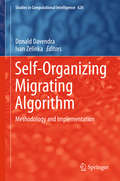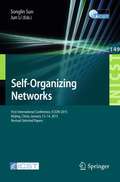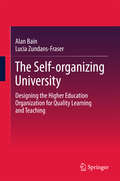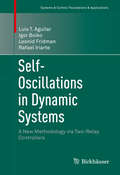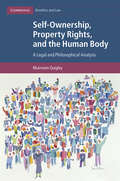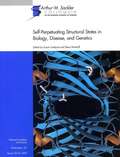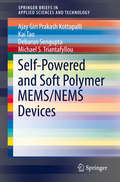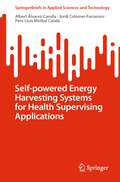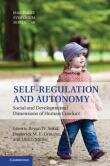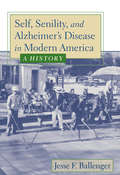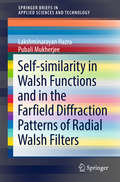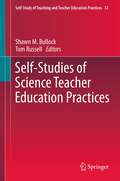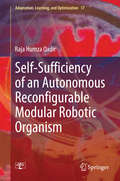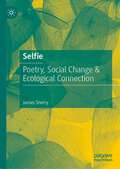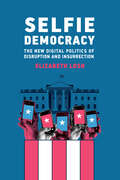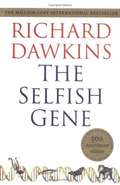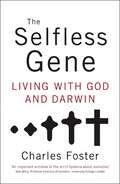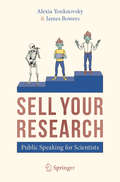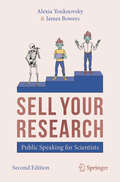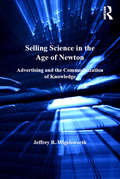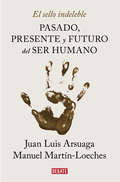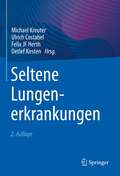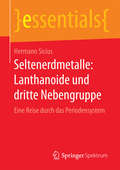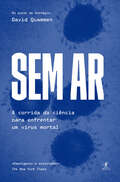- Table View
- List View
Self-Organizing Migrating Algorithm
by Donald Davendra Ivan ZelinkaThis book brings together the current stateof-the-art research in Self Organizing Migrating Algorithm (SOMA) as a novelpopulation-based evolutionary algorithm, modeled on the predator-preyrelationship, by its leading practitioners. As the first ever book on SOMA, this book isgeared towards graduate students, academics and researchers, who are looking fora good optimization algorithm for their applications. This book presents themethodology of SOMA, covering both the real and discrete domains, and itsvarious implementations in different research areas. The easy-to-follow andimplement methodology used in the book will make it easier for a reader toimplement, modify and utilize SOMA.
Self-Organizing Networks
by Jun Li Songlin SunThis book constitutes the thoroughly refereed post-conference proceedings of the International ICST Conference on Self-Organizing Networks, ICSON 2015, held in January 2015 in Beijing, China. The 20 revised full papers presented were carefully reviewed and selected from 24 submissions and cover topics as resource allocation and management, signal processing and transmission, and multimedia service
The Self-organizing University
by Alan Bain Lucia Zundans-FraserThis book challenges the orthodoxy of learning and teaching in higher education with an original change approach entitled the Self-Organizing University (SOU). It assists universities build a comprehensive model of learning and teaching at whole-of-organization scale. The chapters demonstrate how a Self-Organizing University can create: * measurable learning and teaching standards; * student centered program development; * enhanced faculty professional growth and career trajectory; * more efficient and effective organizational design; * better feedback; * powerful use of technologies; * a legitimate connection between quality and productivity. Each chapter includes case examples derived from practical experience that situate the key ideas and concepts in the real day-to-day work of universities. The role of leadership in creating and sustaining a self-organizing university is also a key focus. The chapters target leadership practices that improve learning and teaching quality and productivity and assist universities realize their goals and aspirations for maximizing student learning.
Self-Oscillations in Dynamic Systems
by Luis T. Aguilar Igor Boiko Leonid Fridman Rafael IriarteThis monograph presents a simple and efficient two-relay control algorithm for generation of self-excited oscillations of a desired amplitude and frequency in dynamic systems. Developed by the authors, the two-relay controller consists of two relays switched by the feedback received from a linear or nonlinear system, and represents a new approach to the self-generation of periodic motions in underactuated mechanical systems. The first part of the book explains the design procedures for two-relay control using three different methodologies - the describing-function method, Poincaré maps, and the locus-of-a perturbed-relay-system method - and concludes with stability analysis of designed periodic oscillations. Two methods to ensure the robustness of two-relay control algorithms are explored in the second part, one based on the combination of the high-order sliding mode controller and backstepping, and the other on higher-order sliding-modes-based reconstruction of uncertainties and their compensation where Lyapunov-based stability analysis of tracking error is used. Finally, the third part illustrates applications of self-oscillation generation by a two-relay control with a Furuta pendulum, wheel pendulum, 3-DOF underactuated robot, 3-DOF laboratory helicopter, and fixed-phase electronic circuits. Self-Oscillations in Dynamic Systems will appeal to engineers, researchers, and graduate students working on the tracking and self-generation of periodic motion of electromechanical systems, including non-minimum-phase systems. It will also be of interest to mathematicians working on analysis of periodic solutions.
Self-Ownership, Property Rights, and the Human Body: A Legal And Philosophical Analysis (Cambridge Bioethics And Law #43)
by Muireann QuigleyHow ought the law to deal with novel challenges regarding the use and control of human biomaterials?<P><P> As it stands the law is ill-equipped to deal with these. Quigley argues that advancing biotechnology means that the law must confront and move boundaries which it has constructed; in particular, those which delineate property from non-property in relation to biomaterials. <P>Drawing together often disparate strands of property discourse, she offers a philosophical and legal re-analysis of the law in relation to property in the body and biomaterials. She advances a new defence, underpinned by self-ownership, of the position that persons ought to be seen as the prima facie holders of property rights in their separated biomaterials. <P>This book will appeal to those interested in medical and property law, philosophy, bioethics, and health policy amongst others.<P> Includes a robust discussion of self-ownership and provides a new perspective to the legal literature.<P> Brings together legal and philosophical scholarship in the area and enriches the discourse by taking a wider and more integrated view.<P> Discusses in-depth the legislative and common law background by covering a number of jurisdictions: England and Wales, Scotland, US, Canada and Australia.
Self-Perpetuating Structural States in Biology, Disease, and Genetics
by National Academy of ScienceThe National Academies Press (NAP)--publisher for the National Academies--publishes more than 200 books a year offering the most authoritative views, definitive information, and groundbreaking recommendations on a wide range of topics in science, engineering, and health. Our books are unique in that they are authored by the nation's leading experts in every scientific field.
Self-Powered and Soft Polymer MEMS/NEMS Devices (SpringerBriefs in Applied Sciences and Technology)
by Ajay Giri Kottapalli Kai Tao Debarun Sengupta Michael S. TriantafyllouThis book explores the fabrication of soft material and biomimetic MEMS sensors, presents a review of MEMS/NEMS energy harvesters and self-powered sensors, and focuses on the recent efforts in developing flexible and wearable piezoelectric nanogenerators. It also includes a critical analysis of various energy harvesting principles, such as electromagnetic, piezoelectric, electrostatic, triboelectric, and magnetostrictive. This multidisciplinary book is appropriate for students and professionals in the fields of material science, mechanical engineering, electrical engineering, and bioengineering.
Self-powered Energy Harvesting Systems for Health Supervising Applications (SpringerBriefs in Applied Sciences and Technology)
by Albert Álvarez-Carulla Jordi Colomer-Farrarons Pere Lluís Miribel CatalàThis book highlights the current and recent state-of-the-art developments in energy harvesting systems for health supervising applications. It explores the exciting potential of energy harvesting as a crosscutting field of research to intersect with other areas to envisage new products, solutions, and applications. Among all these new opportunities for synergy, there is a research area that fully matches the features offered by energy harvesting with its power supply's main needs- health supervising (HS), which consists of monitoring the health or operating conditions of anything, such as structures, buildings, public health, environment, etc. The book covers the hand in hand evolution towards a new paradigm: truly self-powered devices based on a single transducer acting as a sensor and as power source simultaneously and efficiently. This evolution is illustrated by the concept and implementation of novel state-of-the-art architecture for self-powered energy harvesting systems for applications that range from structural health monitoring to point-of-care medical devices.
Self-Regulation and Autonomy
by Bryan W. Sokol Frederick M. E. Grouzet Ulrich Müller Bryan W. Sokol Frederick M. E. GrouzetSelf-regulation and autonomy have emerged as key predictors of health and well-being in several areas of psychology. This timely volume brings together eminent scholars at the forefront of this research, which is taking place in disciplines including developmental psychology, developmental neuroscience, social psychology and educational psychology. The contributors present ideas and research findings on the development of self-regulation and autonomy, including their biological bases, antecedents and consequences. Editors Bryan W. Sokol, Frederick M. E. Grouzet and Ulrich Müller have shaped the volume's multidisciplinary perspective on self-regulation and autonomy to reflect the legacy of Jean Piaget, the trailblazing developmental psychologist whose work drew on a diverse body of research.
Self, Senility, and Alzheimer's Disease in Modern America: A History
by Jesse F. BallengerHistorian Jesse F. Ballenger traces the emergence of senility as a cultural category from the late nineteenth century to the 1980s, a period in which Alzheimer's disease became increasingly associated with the terrifying prospect of losing one's self. Changes in American society and culture have complicated the notion of selfhood, Ballenger finds. No longer an ascribed status, selfhood must be carefully and willfully constructed. Thus, losing one's ability to sustain a coherent self-narrative is considered one of life's most dreadful losses. As Ballenger writes "senility haunts the landscape of the self-made man." Stereotypes of senility and Alzheimer's disease are related to anxiety about the coherence, stability, and agency of the self—stereotypes that are transforming perceptions of old age in modern America. Drawing on scientific, clinical, policy, and popular discourses on aging and dementia, Ballenger explores early twentieth-century concepts of aging and the emergence of gerontology to understand and distinguish normal aging from disease. In addition, he examines American psychiatry's approaches to the treatment of senility and scientific attempts to understand the brain pathology of dementia.Ballenger's work contributes to our understanding of the emergence and significance of dementia as a major health issue.
Self-similarity in Walsh Functions and in the Farfield Diffraction Patterns of Radial Walsh Filters
by Lakshminarayan Hazra Pubali MukherjeeThe book explains the classification of a set of Walsh functions into distinct self-similar groups and subgroups, where the members of each subgroup possess distinct self-similar structures. The observations on self-similarity presented provide valuable clues to tackling the inverse problem of synthesis of phase filters. Self-similarity is observed in the far-field diffraction patterns of the corresponding self-similar filters. Walsh functions form a closed set of orthogonal functions over a prespecified interval, each function taking merely one constant value (either +1 or −1) in each of a finite number of subintervals into which the entire interval is divided. The order of a Walsh function is equal to the number of zero crossings within the interval. Walsh functions are extensively used in communication theory and microwave engineering, as well as in the field of digital signal processing. Walsh filters, derived from the Walsh functions, have opened up new vistas. They take on values, either 0 or π phase, corresponding to +1 or -1 of the Walsh function value.
Self-Studies of Science Teacher Education Practices
by Shawn M. Bullock Tom RussellPart of a vital Springer series on self-study practices in teaching and teacher education, this collection offers a range of contributions to the topic that embody the reflections of science teacher educators who have applied self-study methodology to their own professional development. The material recognizes the paradox that lies between classroom science and the education of science teachers: the disciplines of science are often perceived as a quest for right answers, an unintentional by-product of the classroom focus on right answers in student assessment in science. In contrast, the profession of teaching has few right answers and frequently involves the management of conflicting tensions. A dilemma thus arises in science teacher education of how to shift perspectives among student teachers from reductionist to more inclusive attitudes that are open to the mercurial realities of teaching. The self-studies presented here are unique, fresh and stimulating. They include the input of a beginning science teacher as well as science teacher educators from a range of backgrounds and varying levels of experience. In addition, the volume presents a truly international perspective on the issues, with authors hailing from five countries. Providing analysis at the leading edge of education theory, this collection will make fascinating reading for those teaching science--as well as those teaching science teachers.
Self-Sufficiency of an Autonomous Reconfigurable Modular Robotic Organism
by Raja Humza QadirThis book describes how the principle of self-sufficiency can be applied to a reconfigurable modular robotic organism. It shows the design considerations for a novel REPLICATOR robotic platform, both hardware and software, featuring the behavioral characteristics of social insect colonies. Following a comprehensive overview of some of the bio-inspired techniques already available, and of the state-of-the-art in re-configurable modular robotic systems, the book presents a novel power management system with fault-tolerant energy sharing, as well as its implementation in the REPLICATOR robotic modules. In addition, the book discusses, for the first time, the concept of "artificial energy homeostasis" in the context of a modular robotic organism, and shows its verification on a custom-designed simulation framework in different dynamic power distribution and fault tolerance scenarios. This book offers an ideal reference guide for both hardware engineers and software developers involved in the design and implementation of autonomous robotic systems.
Selfie: Poetry, Social Change & Ecological Connection
by James SherrySelfie: Poetry, Social Change & Ecological Connection presents the first general theory that links poetry in environmental thought to poetry as an environment. James Sherry accomplishes this task with a network model of connectivity that scales from the individual to social to environmental practices. Selfie demonstrates how parts of speech, metaphor, and syntax extend bidirectionally from the writer to the world and from the writer inward to identities that promote sustainable practices. Selfie shows how connections in the biosphere scale up from operating within the body, to social structures, to the networks that science has identified for all life. The book urges readers to construct plural identifications rather than essential claims of identity in support of environmental diversity.
Selfie Democracy: The New Digital Politics of Disruption and Insurrection
by Elizabeth LoshHow politicians&’ digital strategies appeal to the same fantasies of digital connection, access, and participation peddled by Silicon Valley.Smartphones and other digital devices seem to give us a direct line to politicians. But is interacting with presidential tweets really a manifestation of digital democracy? In Selfie Democracy, Elizabeth Losh examines the unintended consequences of politicians&’ digital strategies, from the Obama campaign&’s pioneering construction of an online community to Trump&’s Twitter dominance. She finds that politicians who use digital media appeal to the same fantasies of digital connection, access, and participation peddled by Silicon Valley. Meanwhile, smartphones and social media don&’t enable participatory democracy so much as they incentivize citizens to perform attention-getting acts of political expression. Losh explores presidential rhetoric casting digital media as tools of democracy, describes the conflation of gender and technology that contributed to Hillary Clinton&’s defeat in 2016, chronicles the Biden campaign&’s early digital stumbles in 2020, and recounts the TikTok campaign that may have spoiled a Trump rally. She shows that although Obama and Trump may seem diametrically opposed in both style and substance, they both used mobile digital media in ways that reshaped the presidency and promised a new kind of digital democracy. Obama used data and digital media to connect to citizens without intermediaries; Trump followed this strategy to its most extreme conclusion. What were the January 6 insurrectionists doing, as they livestreamed themselves and their cohorts attacking the Capitol, but practicing their own brand of selfie democracy?
The Selfish Gene
by Richard Dawkins"The Selfish Gene" caused a wave of excitement among biologists and the general public when it was first published in 1976. Its vivid rendering of a gene's eye view of life, in lucid prose, gathered together the strands of thought about the nature of natural selection into a conceptual framework with far-reaching implications for our understanding of evolution. Time has confirmed its significance. Intellectually rigorous, yet written in non-technical language, "The Selfish Gene" is widely regarded as a masterpiece of science writing, and its insights remain as relevant today as on the day it was published.
The Selfless Gene: Living with God and Darwin
by Charles FosterIf evolutionary theory is correct, what does that say about creator God?Ever since the famous debate on Darwinism between Huxley and Wilberforce in 1860, there has been little real conversation between the scientific community and much of the Christian world. This book offers the prospect of reconciliation between what are seen as two opposing worldviews.With remarkable insight and skill, Foster shows that most evolutionary theory and its consequences are easily reconciled with Christian orthodoxy and explores the ethical problems of natural selection in a fresh and invigorating way.Charles Foster insists on getting to the heart of the topic and succeeds through a scientific and biblical analysis that is second to none. The Selfless Gene has the potential to become required reading for theologians and laypeople alike.
SELL YOUR RESEARCH: Public Speaking for Scientists
by Alexia Youknovsky James BowersPublic speaking is an essential component in the life of a scientist, whatever your level of career. In this book, the authors describe a tried-and-tested technique for preparing a presentation: the SELL Method. Following these three simple steps - Skeleton, Envelope, Life & Logistics - will help you make the most out of any talk. Whether it be a 3-minute pitch or an hour-long plenary session, you will find pages of advice, theory and practical exercises enabling you to SELL YOUR RESEARCH with impact.For scientists these days, the work is not done until it is communicated. And now that problem is solved. Solidly researched and immaculately written, Sell Your Research is a goldmine of useful advice. Whether you are brimming with confidence or just setting out, this gem of a guidebook will improve every presentation and nurture every budding science communicator.Dr. Stephen Webster, Director of Science Communication Unit, Imperial College LondonPublic speaking is one of the most intimidating but crucial tasks in a scientist’s career. This book provides a welcoming, clear, step-by-step guide to improving your presentations at every level. Reading it and following its advice will make your science talks less frightening and more enjoyable. Dr. Laura Helmuth, Health, Science & Environment Editor, Washington Post
SELL YOUR RESEARCH: Public Speaking for Scientists
by Alexia Youknovsky James BowersPublic speaking is an essential component in the life of a scientist, whatever your level of career. In this book, the authors describe a tried-and-tested technique for preparing a presentation: the SELL method. Following these three simple steps—Skeleton, Envelope, and Life and Logistics—will help you make the most out of any talk. Whether it be a 3-minute pitch or an hour-long plenary session, you will find pages of advice, theory, and practical exercises enabling you to Sell Your Research with impact. This second edition is enriched with new insights in storytelling, online presenting, and speaking with the media on hot topics. For scientists these days, the work is not done until it is communicated. And now that problem is solved. Solidly researched and immaculately written, Sell Your Research is a goldmine of useful advice. Whether you are brimming with confidence or just setting out, this gem of a guidebook will improve every presentation and nurture every budding science communicator. Dr. Stephen Webster, former Director of Science Communication Unit, Imperial College London Public speaking is one of the most intimidating but crucial tasks in a scientist’s career. This book provides a welcoming, clear, step-by-step guide to improving your presentations at every level. Reading it and following its advice will make your science talks less frightening and more enjoyable. Dr. Laura Helmuth, Editor In Chief, Scientific American
Selling Science: Polio and the Promise of Gamma Globulin
by Stephen E. MawdsleyToday, when many parents seem reluctant to have their children vaccinated, even with long proven medications, the Salk vaccine trial, which enrolled millions of healthy children to test an unproven medical intervention, seems nothing short of astonishing. In Selling Science, medical historian Stephen E. Mawdsley recounts the untold story of the first large clinical trial to control polio using healthy children--55,000 healthy children--revealing how this long-forgotten incident cleared the path for Salk's later trial. Mawdsley describes how, in the early 1950s, Dr. William Hammon and the National Foundation for Infantile Paralysis launched a pioneering medical experiment on a previously untried scale. Conducted on over 55,000 healthy children in Texas, Utah, Iowa, and Nebraska, this landmark study assessed the safety and effectiveness of a blood component, gamma globulin, to prevent paralytic polio. The value of the proposed experiment was questioned by many prominent health professionals as it harbored potential health risks, but as Mawdsley points out, compromise and coercion moved it forward. And though the trial returned dubious results, it was presented to the public as a triumph and used to justify a federally sanctioned mass immunization study on thousands of families between 1953 and 1954. Indeed, the concept, conduct, and outcome of the GG study were sold to health professionals, medical researchers, and the public at each stage. At a time when most Americans trusted scientists, their mutual encounter under the auspices of conquering disease was shaped by politics, marketing, and at times, deception. Drawing on oral history interviews, medical journals, newspapers, meeting minutes, and private institutional records, Selling Science sheds light on the ethics of scientific conduct, and on the power of marketing to shape public opinion about medical experimentation.
Selling Science in the Age of Newton: Advertising and the Commoditization of Knowledge (Science, Technology And Culture, 1700-1945 Ser.)
by Jeffrey R. WigelsworthSelling Science in the Age of Newton explores an often ignored avenue in the popularization of science. It is an investigation of how advertisements in London newspapers (from approximately 1687 to 1727) enticed consumers to purchase products relating to science: books, lecture series, and instruments. London's readers were among the first in Europe to be exposed to regular newspapers and the advertisements contained in them. This occurred just as science began to captivate the nation's imagination due, in part, to Isaac Newton's rising popularity following the publication of his Principia (1687). This unique moment allows us to see how advertising helped shape the initial public reception of science. This book fills a substantial gap in our understanding of science and the culture in which it developed by examining the medium of advertising and its function in the discourse of both early-modern science and commerce. It answers questions such as: what happens to science once it is a commodity; how are consumers tempted to purchase science amidst a sea of other commodities; how is the reading public encouraged to give social acceptance to facts of nature; and how did marketing campaigns craft newspapers readers into a source of validation for the items of science advertised? In an age where the production of scientific knowledge increasingly relied upon sales to many rather than the endorsement of a single wealthy patron, marketing was the key to success.
El sello indeleble: Pasado, presente y futuro del ser humano
by Juan Luis Arsuaga Manuel Martín-LoechesCómo la evolución nos ha diferenciado del resto de seres vivos: una apasionante investigación sobre qué nos hace humanos. ¿Por qué estamos los humanos en la Tierra y qué nos ha hecho diferentes de los chimpancés y de las demás especies que la pueblan? ¿Son muy antiguas las razas humanas? ¿Responde la evolución a un plan y tiende hacia un progreso? Elaborar la lista de nuestras señas de identidad y establecer su origen en el tiempo es una tarea ardua y está lejos de haber sido completada, pero Juan Luis Arsuaga y Manuel Martín-Loeches realizan una brillante exposición en la que nos muestran que nuestros rasgos humanos han surgido, no solo de la selección natural, sino de la selección producida por el "carácter hostil" de la sociedad humana. Contra esta también había que luchar para sobrevivir y dejar descendencia. Este hecho tan relevante como relegado por la ciencia nos permite conocer mejor nuestra historia, y nos ayuda a especular cómo será el hombre del futuro. Una visión original y valiente de nuestro pasado, presente y futuro. Un libro destinado a convertirse en referencia. Reseña:«El paleontólogo Juan Luis Arsuaga y el neurocientífico Manuel Martín-Loeches abordan el problema, aún sin resolver, de qué es exactamente un ser humano. Son muchas las dudas que se plantean. ¿Seguiremos evolucionando? Y si es así, ¿hacia dónde?»ABC
Seltene Lungenerkrankungen
by Felix Jf Herth Michael Kreuter Ulrich Costabel Detlef KirstenDieses Buch schließt eine Lücke und erspart mühsame Recherchearbeit. Das interdisziplinäre Herausgeber- und Autorenteam bestehend aus Pneumologen, Rheumatologen Radiologen, und Pathologen stellt seltene Erkrankungen der Lunge übersichtlich und systematisch nach den folgenden Kriterien dar: Ätiologie, Epidemiologie, Klinik, Diagnostik, Pathologie, Radiologie, Therapie und Prognose. Ob idiopathische interstitielle Pneumonien, Sarkoidose, Lungenbeteiligungen bei Kollagenosen, Lymphangiolyomyomatose, Alveolarproteinose, eosinophile Pneumonien, Lungenemphysem bei Alpha-1 Antitrypsinmangels, Bronchiolitiden , Mucoviszidose oder anderen seltenen Erkrankungen, der Leser erhält praxisnahe Antworten auf seine Fragen von bekannten Experten ihres Fachgebietes. Die 2. Auflage wurde komplett aktualisiert und um folgende Themen erweitert: Seltene berufsbezogene Lungenerkrankungen, seltene Infekte und Zwerchfellparese.
Seltenerdmetalle: Eine Reise durch das Periodensystem (essentials)
by Hermann SiciusHermann Sicius bringt dem Leser in knapper Form alle wichtigen Informationen rund um eine wichtige Klasse metallischer Rohstoffe nahe. Die insgesamt achtzehn Metalle der Lanthanoide (Seltenerdmetalle) sowie der dritten Nebengruppe sind nur einem kleinen Teil der Oeffentlichkeit bekannt, aber von großer Bedeutung für viele zukünftige Technologien.
Sem ar: A corrida da ciência para derrotar um vírus mortal
by David QuammenDavid Quammen, um dos mais conceituados jornalistas científicos, traz-nos toda a verdade sobre o SARS-CoV-2, uma narrativa cativante e essencial para perceber a origem da pandemia que moldou a atualidade. Em 2020, o hemisfério ocidental foi surpreendido por um novo coronavírus e uma crise pandémica com consequências globais. No entanto, para os cientistas que conheciam e estudavam os vírus zoonóticos, o aparecimento do SARS-CoV-2 não foi inesperado. Há muito que alertavam inequivocamente para a probabilidade muito elevada de uma pandemia.Com base em entrevistas a mais de 90 virologistas, epidemiologistas e outras autoridades, David Quammen, um dos mais reputados jornalistas científicos da atualidade, explora as consequências da ação humana na passagem do vírus dos animais para a nossa espécie e analisa com objetividade as hipóteses sobre a sua origem, rejeitando conspirações e teorias pouco fundamentadas. Explica ainda como é provável que os humanos tenham de adaptar-se para conviver em permanência com o SARS-CoV-2, a circular entre nós e a atormentar-nos com as suas intermináveis mutações. Sem ar reflete o espírito colaborativo da ciência, ao traçar um retrato fulgurante do esforço que uniu a comunidade científica em todo o mundo para decifrar a natureza do vírus que redefiniu a atualidade, parar a sua propagação e impedir que se repita. Os elogios da crítica: «Empolgante e assustador. Um relato apaixonado e esclarecedor sobre a crise definidora da atualidade.» The New York Times «Sem ar, tal como o vírus que retrata, é o culminar dramático da ideia […] de que a história da ecologia viral, na sua vertente científica, poderá facilmente tornar-se na maior história do planeta Terra.» The Atlantic «Três anos depois do início da pandemia, Quammen, prolífero autor e jornalista científico, desvela os mais variados detalhes sobre o esforço para investigar a propagação da covid-19 e identificar o que a tornou tão ameaçadora… Uma crónica de investigação científica, escrita de modo envolvente.»The Wall Street Journal «Sem ar apresenta uma abrangente história científica da pandemia, ligando as peças do puzzle que, à época, pareciam tão desconexas.» Science News «Uma nova história credível da covid-19 e dos seus antecessores… [Quammen] constrói um retrato exímio da evolução viral que culminou na covid-19. Informação perturbadora sobre saúde pública comunicada com brilhantismo por um perito.» Kirkus Reviews «Uma leitura essencial para quem queira perceber melhor a pandemia.» Publishers Weekly«Há poucos escritores que consigam compreender as cadeias de aminoácidos que dão a estes vírus os seus códigos particulares, muito menos os que conseguem relacioná-los com outros vírus SARS. E são ainda mais raros os que têm os dons literários necessários para tornar a genómica compreensível para um leigo. Felizmente, David Quammen […] é um deles.» The Guardian
